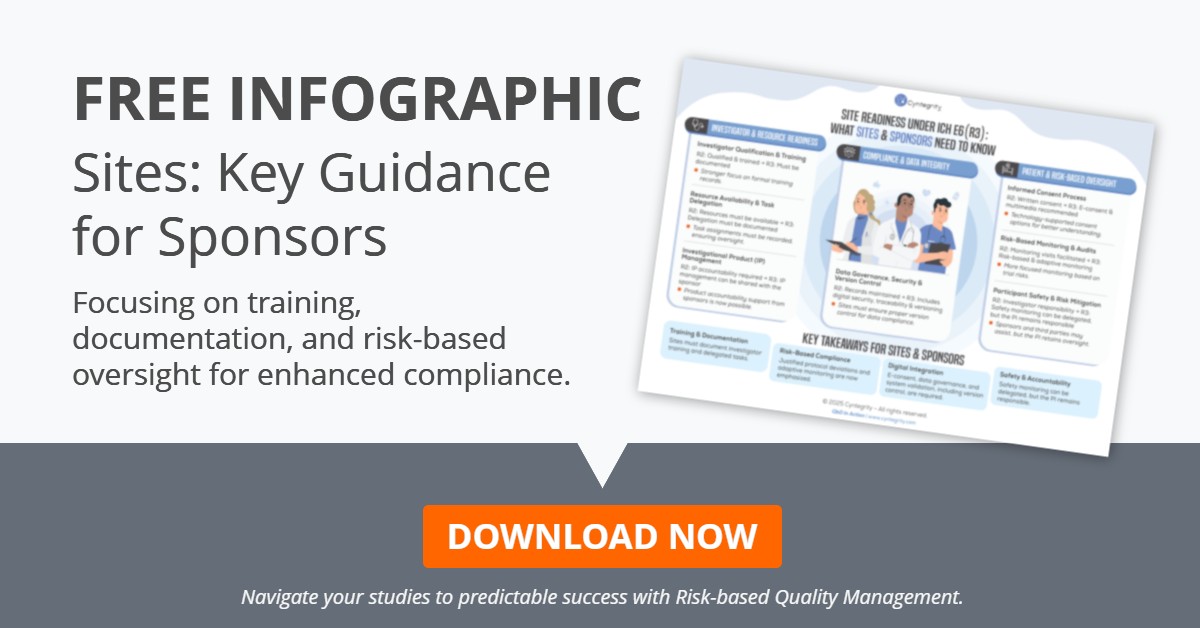A Revolutionary Shift in Clinical Research
Introduction
The International Council for Harmonisation (ICH) has taken a significant step forward in advancing clinical research with the release of the draft guidelines of E6(R3) on May 19, 2023. This article will discuss the key highlights of the E6(R3) guidelines, identify areas that may benefit from additional guidance, and compare its facets with the E8(R1) guidelines.
The ICH E6(R3) Guidelines – A Comprehensive Overview
The E6(R3) guidance marks a pivotal shift in the ICH’s approach to clinical research by emphasizing Quality by Design (QbD), Risk-Based Quality Management (RBQM), and the critical-to-quality (CTQ) factors approach.
- Quality by Design (QbD): The guidelines emphasize the need to integrate quality into the design phase of clinical trials, ensuring patient safety and data integrity right from the outset (Section 3).
- Risk-Based Quality Management (RBQM): The guidance underscores the need to identify, assess, control, communicate, and review risks to trial quality at both the system and clinical trial level (Section 5).
- Critical-to-Quality Factors: The guidance details how to identify factors critical to the quality of the trial and how to ensure these factors are maintained within acceptable ranges throughout the trial (Section 3).
The guideline underlines the critical importance of maintaining high ethical standards, thorough record keeping, and a robust quality management system in the conduct of clinical trials to ensure the safety and rights of trial participants and the integrity of the trial data.
Where Further Guidance May Be Beneficial
While the E6(R3) guidelines represent a substantial leap forward, there is potential for additional guidance in some areas. These include:
- Clarifying Role Definitions (Section 1.23-1.56): While the E6(R3) guideline details the responsibilities of sponsors and investigators, nuanced situations such as investigator-initiated trials may blur these roles. Additional guidance on managing these scenarios can strengthen trial oversight.
- Deepening Ethical Considerations (Section 1.59-1.63): Despite a strong ethical foundation, the complexity of ethics in clinical trials calls for expanded guidance. Issues like dealing with vulnerable populations, ensuring informed consent in diverse cultural or low-literacy settings, and managing data privacy in a digital world could be explored more thoroughly.
- Enhancing Record Keeping Guidance (Section 1.11-2.38): The guidelines define essential and potentially essential records, yet as electronic data capture rises in clinical trials, more detail on managing, storing, and securing digital records would be beneficial.
- Managing Non-Compliance: While E6(R3) stresses the importance of non-compliance protocols, further guidance on handling various types of non-compliance and their potential implications could enhance trial integrity.
- Quality by Design (QbD) and Risk-Based Quality Management (RBQM): As QbD and RBQM methodologies gain traction, practical instructions for their implementation could offer a more structured approach, improving standardization across trials.
- Managing Deviations from Critical to Quality (CTQ) Ranges: The guidelines mention CTQ factors but could give clearer directions on managing deviations from CTQ ranges, especially substantial, recurring, or safety-impacting deviations.
- Role and Functioning of Data Monitoring Committees (DMC): Although E6(R3) recognizes the DMC’s role in trial safety monitoring, additional information on their duties and functioning could enrich understanding and effectiveness.
- Managing Unforeseen Risks During Trial Execution: Explicit procedures for managing unforeseen risks can ensure quick and suitable responses, maintaining trial integrity amidst unexpected challenges. Detailed guidance on risk identification, evaluation, control, and communication could be advantageous.
Incorporating these considerations would make E6(R3) an even more comprehensive tool for clinical trial conduct, catering to the evolving needs of clinical trial practitioners.
Addressing Key Challenges in Clinical Trials: The Role of ICH E6(R3) and E8(R1) Guidelines
The ICH E6(R3) and E8(R1) guidelines aim to address several key aspects and problems in the clinical trial industry:
Standardization of Clinical Trials: Clinical trials conducted across the globe are diverse in terms of design, methodology, and conduct. These guidelines aim to establish a universal set of standards to ensure reliable and valid data generated from these trials.
Ensuring Ethical Conduct: Ethical conduct in clinical trials is paramount. These guidelines provide a comprehensive overview of the ethical considerations that should be adhered to, thereby ensuring trial participants’ rights, safety, and well-being.
Quality Management: Clinical trials can be complex, and maintaining a high level of quality is crucial. The guidelines introduce concepts like Quality by Design (QbD) and Risk-Based Quality Management (RBQM) to ensure trials are well-designed and effectively managed.
Effective Data Management: The guidelines provide instructions on handling, record keeping, and reporting trial data to ensure its integrity and accuracy.
Roles and Responsibilities: Clear delineation of roles and responsibilities, such as investigators, sponsors, and ethics committees, is crucial for a successful trial. These guidelines help define these roles and responsibilities in detail.
Risk Management: Unforeseen risks can compromise a trial’s integrity. The guidelines aim to facilitate efficient risk identification, evaluation, control, and communication to manage unexpected challenges.
The underlying purpose of these guidelines is to improve the design, conduct, and overall quality of clinical trials, thereby ensuring the validity and reliability of the data produced, leading to safer and more effective therapeutic products.
Comparing the E6(R3) and E8(R1) Guidelines: Unifying, Differing, and Complementing Aspects
| Areas of Comparison | E6(R3) | E8(R1) |
|---|---|---|
| Focus | Emphasizes on QbD, RBQM, and CTQ | Focuses on design considerations for clinical studies |
| Quality Management | Quality should be built into the design phase | Quality design should be considered at the planning stage |
| Risk Management | Detailed guidance on managing risks at system and trial level | Discusses safety monitoring but does not delve into risk management |
| Monitoring | Role of data monitoring committee in ensuring safety | Importance of an independent data monitoring committee |
| Study Reporting | Provides some guidance on reporting results | Detailed instructions on reporting clinical study results |
Conclusion
The draft guidelines of E6(R3) represent a significant evolution in clinical trial guidance, bringing with it a more dynamic, risk-based approach to clinical trials. While there are areas that could potentially benefit from additional guidance, this is a critical step in improving the quality and safety of clinical research. Comparatively, the E8(R1) guidelines offer valuable complementary information, particularly around the specifics of study design and reporting, demonstrating how these two guidelines can effectively work together to shape the future of clinical trials.
Resource
Don’t miss out on understanding the full impact of the upcoming changes to the new ICH GCP E6(R3) revision. The ICH has created a detailed PowerPoint presentation that extensively reviews these changes. It’s an invaluable resource for anyone involved in the field. Click the button to download the presentation and stay ahead of the curve with the latest updates in clinical trial guidelines.







